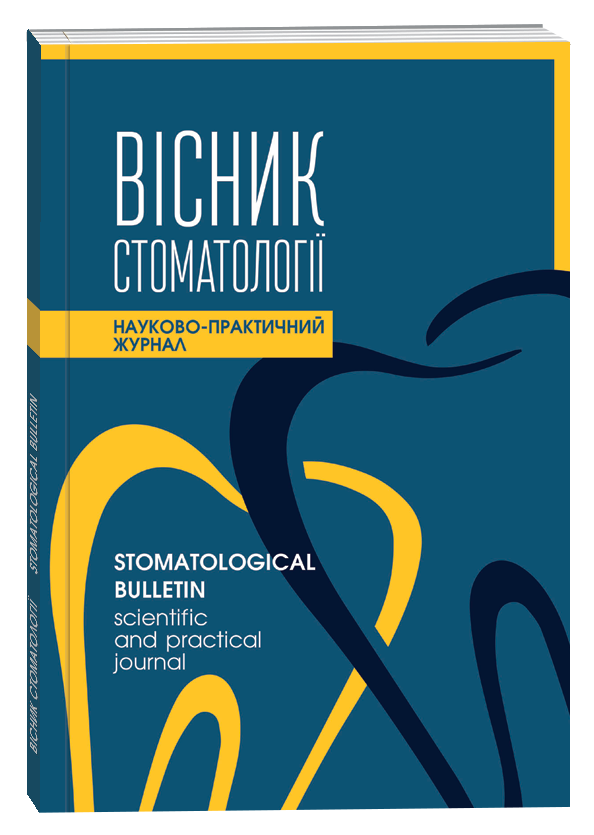THROMBOCYTES AND SOME BIOCHEMICAL PARAMETERS OF BLOOD IN PATIENTS WITH DIFFERENT RESULTS OF HEALING OF FACIAL SOFT TISSUES
DOI:
https://doi.org/10.35220/2078-8916-2022-43-1.7Keywords:
biochemical analysis of blood, wounds of the maxillofacial area, wound healing, regenerative potential of damaged tissuesAbstract
The ability to regenerate is inherent in every tissue of the human body. The problem of pathological wound healing remains relevant due to the growing aesthetic requirements of patients. The regenerative ability of damaged tissues ensures the restoration of function. Purpose of the study. Analyze some biochemical parameters of blood in patients with different results of healing of wounds of soft tissues of the face. Material and methods of research. Based on the results of the conducted studies, the regenerative ability of damaged tissues was studied. During hospitalization, general clinical studies were conducted. A series of laboratory tests (general and biochemical blood tests) was performed in patients of the main and control groups (with and without complications, respectively). A comprehensive study of the course of the wound process was conducted in 30 patients with wounds of the skin and subcutaneous tissue. Patients range in age from 18 to 69 years. The average age of patients is 43.5 years. Statistical processing of the obtained results was performed using the Microsoft Excel program. Results and their discussion. The obtained results of statistical analysis p<0.01 indicate a significant difference in biochemical parameters in patients with suture divergence and without complications of wound healing. Conclusions. Based on the conducted studies, the level of total blood protein and platelet count are important components of the body’s regeneration potential, as they reflect the body’s readiness to repair damaged tissues. A significant decrease in total blood protein levels and platelet count may be a risk factor for postoperative wound healing complications. Analysis of laboratory tests builds an important foundation for predicting possible complications, drawing up a treatment plan, and correcting existing somatic diseases. According to the author, it is important to conduct repeated studies, which makes it possible to determine the course of the infectious process and the effectiveness of treatment.
References
Юшков Б.Г. Тромбоциты и регенерация. Бюллетень сибирской медицины. 2021. № 2(20). С. 216–227.
Добровольский А.Б. Актуальные вопросы гемостаза. Клиническая лабораторная диагностика. 2014. № 59(9). С. 62–65.
Цепколенко А.В. Иммунная система и регенеративный потенциал кожи. Дерматологія та венерологія. 2017. № 3. С. 27–37.
Фенчин К.Н. Заживление ран. Киев : Здоровье, 1979. 173 с.
Heather E. desJardins-Park, Shamik Mascharak, Malini S. Chinta, Derrick C. Wan Michael T. Longaker. The Spectrum of Scarring in Craniofacial Wound Repair. Frontiers in physiology. 2019. № 10. Р. 322. doi:10.3389/fphys.2019.00322.
Takeo Takeo M., Lee W., Ito M. Wound Healing and Skin Regeneration. Cold Spring Harb Perspect Med 2015; 5:a023267 doi: 10.1101/cshperspect.a023267.
Yaprak E., Kasap M., Akpinar G., Islek E.E., Sinanoglu A.. Abundant proteins in platelet-rich fibrin and their potential contribution to wound healing: An explorative proteomics study and review of the literature. Journal of dental sciences. 2018. № 13(4). Р. 386–395.
Rayes J., Bourne J.H., Brill A., Watson S.P. The dual role of platelet-innate immune cell interactions in thromboinflammation. Research and practice in thrombosis and haemostasis. 2020. № 4(1). Р. 23–35.
Caley M.P., Martins V.L, O’Toole E.A. Metalloproteinases and Wound Healing. Adv Wound Care (New Rochelle). 2015. Vol. 4, № 4. P. 225–233.
Bayer A., Lammel J., Lippross S., Klüter T., Behrendt P., Tohidnezhad M., Harder J. Platelet-released growth factors induce psoriasin in keratinocytes: Implications for the cutaneous barrier. Annals of Anatomy – Anatomischer Anzeiger. 2017. № 213. Р. 25–32. doi: 10.1016/j.aanat.2017.04.002.









